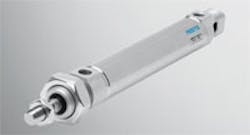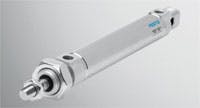Self-adjusting cushions handle changing loads and speeds
Festo Corp., Hauppauge, N.Y., has developed a self-adjusting cushioning system for its widely used DSNU series round-cylinder pneumatic actuators. The cushion relies on specially engineered air channels that provide phased venting of the cushioning air, letting the system automatically adapt its characteristics should cylinder loads and speeds change.
The cushions, named PPS, provide dynamic but gentle damping as the load nears the end of the cylinder without the need for manual adjustment. Until now, users had to manually adjust the end-position cushioning on cylinders. However, tuning by hand often means that actuators are less than perfectly adjusted. Underdamping results in excessive impacts, more noise, and increased wear; overdamping risks slow cycle times.
The self-adjusting cushions provide just the right damping even if parameters such as friction and pressure change, says Festo. They also reduce acceleration forces acting on mating components and work pieces. This cuts down on wear and minimizes shock and vibration. What is more, compared to shock absorbers, self-adjusting cushions are less expensive and more robust, according to the company.
DSNU round cylinders with the new cushions span diameters from 16 to 63 mm, with stroke lengths to 500 mm. DSNU actuators already offer users a choice of polymer or manually- adjustable pneumatic end-position cushioning for applications involving low and high impact-energy levels, respectively. The self-adjusting PPS cushions are primarily intended for medium impact-energy applications involving loads to about 5 kg and speeds to approximately 1 m/sec.
Because the exhaust flow from the pneumatic cushioning chamber changes over the damping stroke, Festo’s PPS system works with most commonly permissible speed and mass combinations, making it suitable for a wide range of applications. According to Festo product manager Steve Sands, about 80% of applications that rely on DSNU cylinders with manually adjusted cushions would benefit from the new PPS self-adjusting cushioning. “Given that the PPS system actually costs less than our manually-adjustable technology, and always provides optimum cushioning, we expect it to be a popular choice with machine builders,” says Sands.
Self-adjusting cushions also hold considerable advantages in terms of machine set up and commissioning. Manually adjusting the endposition damping of linear actuators is time-consuming, and can only be done effectively once the actuator is installed and operating under load conditions. By then, the automation supplier is invariably under pressure to complete the task as quickly as possible. It also frequently involves two people — one operating the appropriate pneumatic valve, the other adjusting the actuator’s damping characteristics. As with all moving parts, access can be potentially hazardous, which means that safety considerations dictate that only experienced personnel should perform these adjustments.
Festo estimates that on average, the new PPS cushioning system will help users shave five minutes off a cylinder’s installation and set-up time. For a typical application, such as a package sorting system with, say, 60 cylinder-driven routing stations, this would save five man-hours.
Festo’s PPS self-adjusting cushions have no settings to change, are tamper-proof, and designed for long, maintenance-free service life. DSNU pneumatic cylinders equipped with the new PPS system are fully interchangeable with the company’s manually- adjustable models.
PPS cushioning is also available on the company’s CRDSNU corrosionresistant stainless steel round-line cylinders. Because there is no external cushioning-adjustment screw, this eliminates any potential for dirt entrapment around the screw for a cleaner surface with better wash-down characteristics.
For more information, contact Festo Corp., 395 Moreland Rd., Hauppauge, NY 11788, (631) 435-0800, www.festo.com/us.



